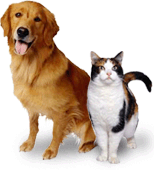Animals, Pet Food
(here's what pets are really eating)
A Few Words about the content of pet food
Do you think your commercially prepared pet food consists of plump whole chickens, choice cuts of beef, fresh grains, and all the wholesome nutrition your dog or cat will ever need?
These are the images pet food manufacturers claim through the media and advertising. This is what the $11 billion per year U.S. pet food industry wants consumers to believe they are buying when they purchase their products.

What most consumers don't know is that the pet food industry is an extension of the human food and agriculture industries. Pet food provides a market for slaughterhouse offal, grains considered "unfit for human consumption," and similar waste products to be turned into profit. This waste includes intestines, udders, esophagi, and possibly diseased and cancerous animal parts.
Although the purchase price of pet food does not always determine whether a pet food is good or bad, the price is often a good indicator of quality. It would be impossible for a company that sells a generic brand of dog food at $9.95 for a 40-lb. bag to use quality protein and grain in its food. The cost of purchasing quality ingredients would be much higher than the selling price.
Pet food is not from "choice parts" of animals!
The protein used in pet food comes from a variety of sources. When cattle, swine, chickens, lambs, or other animals are slaughtered, the choice cuts such as lean muscle tissue are trimmed away from the carcass for human consumption. About 50% of every food-producing animal does not get used in human foods. Whatever remains of the carcass; such as, bones, blood, intestines, lungs, ligaments, and almost all the other parts not generally consumed by humans is used in pet food, animal feed, and other products. These "other parts" are known as "by-products," "meat-and-bone-meal," or similar names on pet food labels.
The Pet Food Institute, the trade association of pet food manufacturers, acknowledges the use of by-products in pet foods as additional income for processors and farmers: "The growth of the pet food industry not only provided pet owners with better foods for their pets, but also created profitable additional markets for American farm products and for the byproducts of the meat packing, poultry, and other food industries which prepare food for human consumption."
Meat and poultry meals, by-product meals, and meat-and-bone meal are common ingredients in pet foods. The term "meal" means that these materials are not used fresh, but have been rendered. What is rendering? Rendering, as defined by Webster's Dictionary, is "to process as for industrial use: to render livestock carcasses and to extract oil from fat, blubber, etc., by melting." Home-made chicken soup, with its thick layer of fat that forms over the top when the soup is cooled, is a sort of mini-rendering process. Rendering separates fat-soluble from water-soluble and solid materials, removes most of the water, and kills bacterial contaminants, but may alter or destroy some of the natural enzymes and proteins found in the raw ingredients. Meat and poultry by-products, while not rendered, vary widely in composition and quality.
Some pet foods can be dangerous to pets
What can the feeding of such products do to your companion animal? Some veterinarians claim that feeding slaughterhouse wastes to animals increases their risk of getting cancer and other degenerative diseases. The cooking methods used by pet food manufacturers; such as, rendering, extruding (a heat-and-pressure system used to "puff" dry foods into nuggets or kibbles), and baking do not necessarily destroy the hormones used to fatten livestock or increase milk production, or drugs such as antibiotics or the barbiturates used to euthanize animals.
